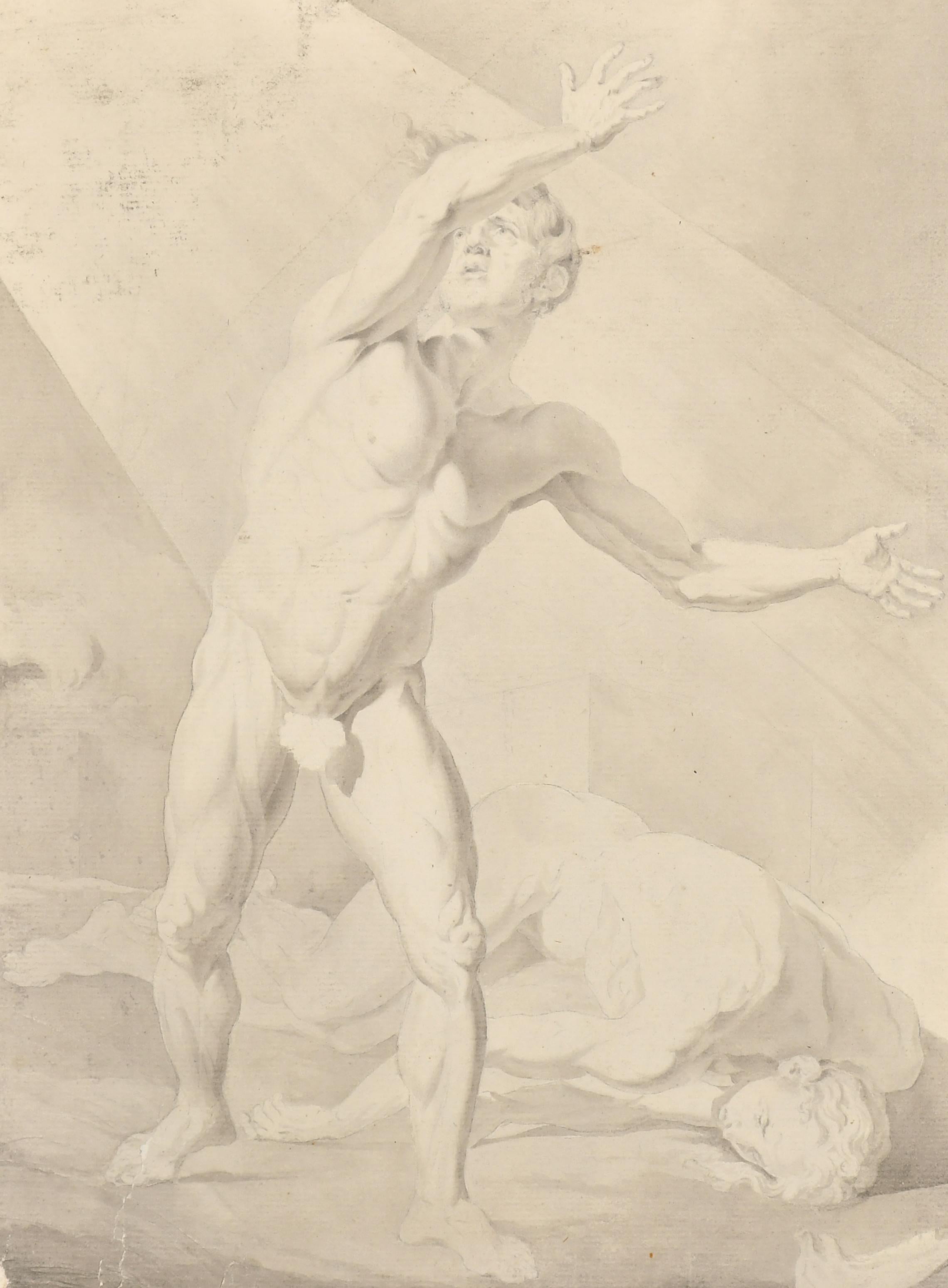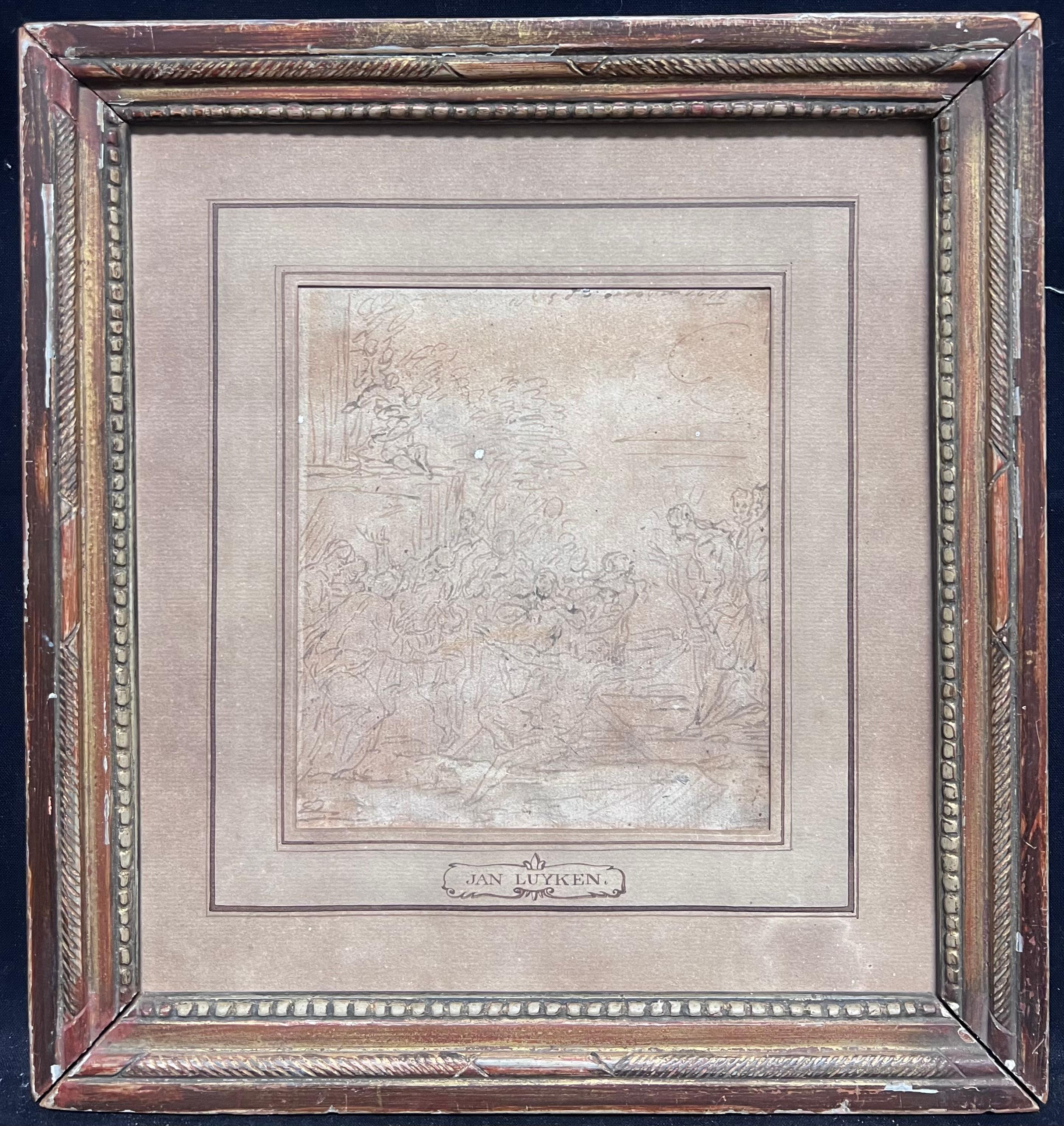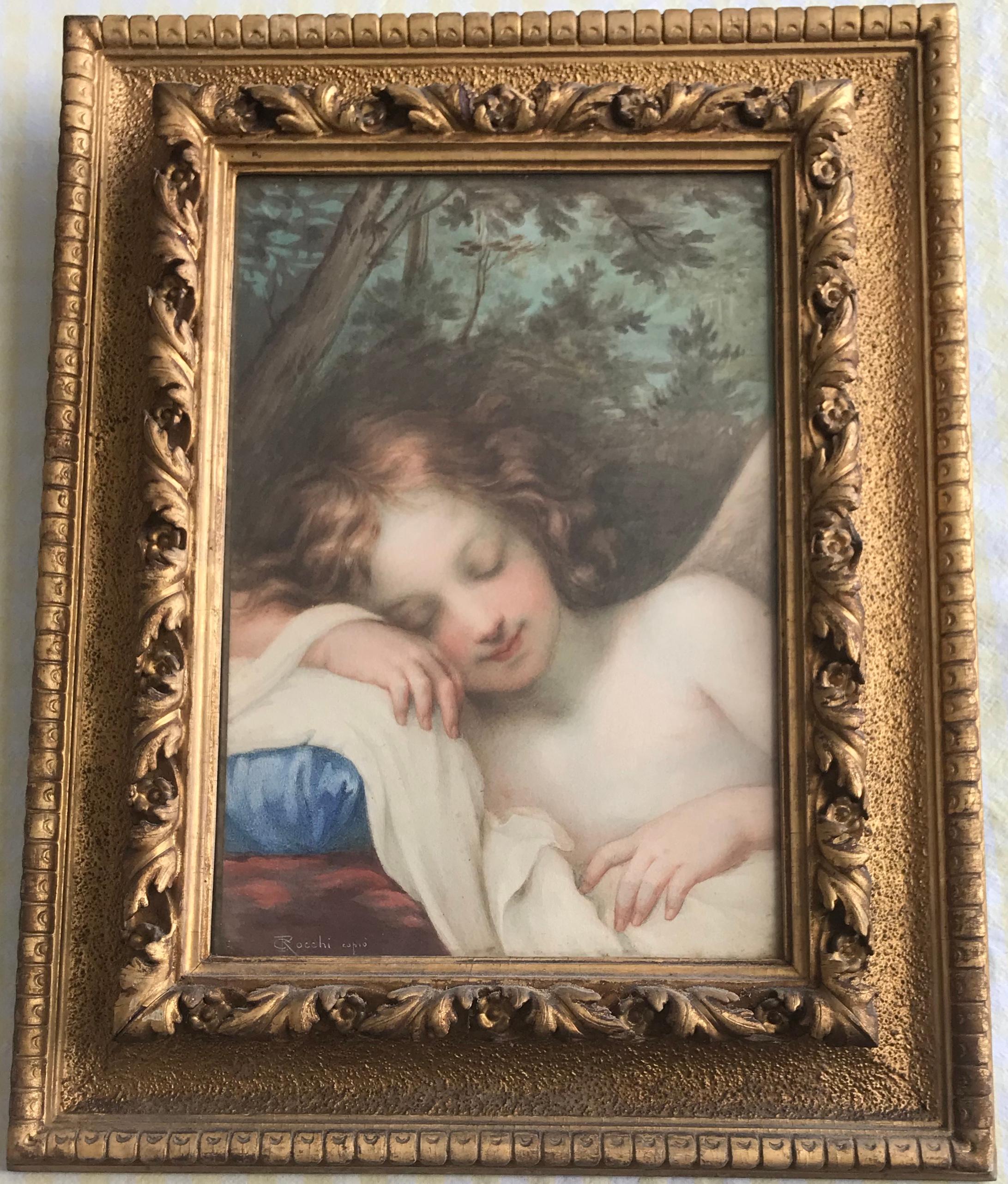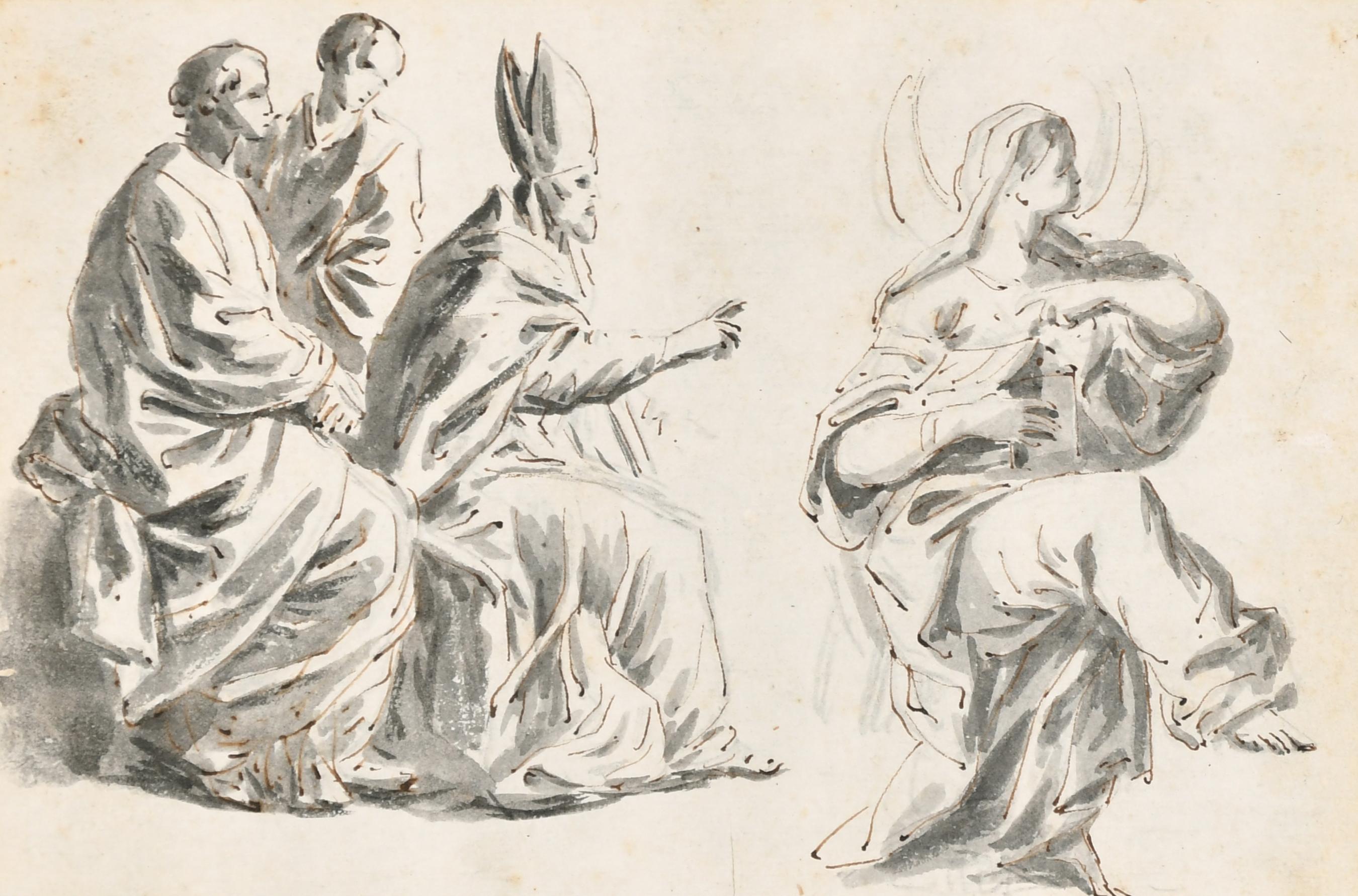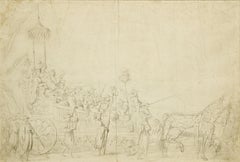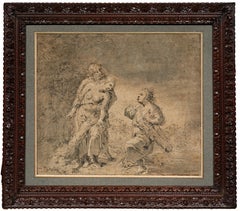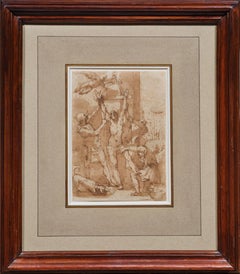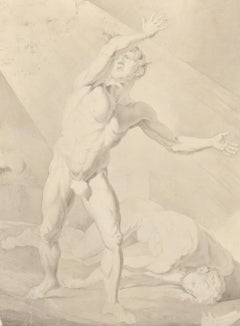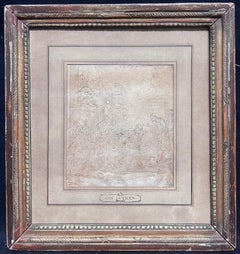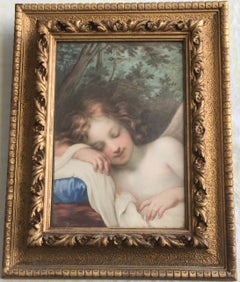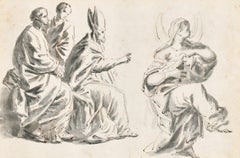Items Similar to Three studies executed in the Pitti Palace in 1761 by Jean-Honoré Fragonard
Want more images or videos?
Request additional images or videos from the seller
1 of 10
Jean-Honoré FragonardThree studies executed in the Pitti Palace in 1761 by Jean-Honoré Fragonard1761
1761
About the Item
This brilliant study sheet, of which we present here a counterproof, is a souvenir of Fragonard's return journey from Italy. Between April and September 1761, he accompanied the abbot of Saint-Non on his way back to France. Three studies after the masters taken from the Pitti Palace’s gallery in Florence are gathered on this sheet. Although The Ecstasy of Saint Margaret of Cortona by Giovanni Lanfranco and The Holy Family with Saint Elizabeth after Rubens present classical themes, the presence of a mocking angel, a "victorious love" of secular appearance, heralds the gallant scenes that would make the artist famous after his return to Paris.
1. The first stay in Italy, a decisive step in Jean-Honoré Fragonard's artistic development
Jean-Honoré Fragonard was born in Grasse in 1732 where his father worked as a glove maker. The family moved to Paris around 1738. At the age of 13, Jean-Honoré's artistic talents were noticed by the notary with whom he worked as a clerk. After briefly attending Jean-Siméon Chardin's workshop, the young Fragonard joined François Boucher's workshop as an apprentice. It was thanks to Boucher that he affirmed his talent and learned to copy the masters. In 1752, he won the Grand Prix of the Royal Academy of Painting, which allowed him to join the Royal School of Protected Pupils directed at the time by Carle Van Loo. In 1756 he left for the French Academy in Rome where he stayed until 1761.
During this stay he made friends with Jean-Claude Richard de Saint-Non, the famous abbot of Saint-Non, who became his protector and main patron. Although we do not know the exact date of their meeting, during the summer of 1760 they stayed together at the Villa d'Este in Tivoli for several weeks. In March 1761 the abbot de Saint-Non sent Fragonard to Naples at his own expense.
The abbot of Saint-Non then offered Fragonard to accompany him on his return trip to France. Fragonard was 29 years old in 1761 (five years younger than the abbot) and had not yet achieved fame when he left Italy. They left Rome in April 1761 and travelled together for over five months. The abbot wrote to his brother about Fragonard: "Monsieur Fragonard is all fire; his drawings are very numerous: one does not wait for the other; they enchant me. I find spell in them"...
2. The drawings made for the abbot of Saint-Non on his return trip to France
As was customary, the patron paid the travel expenses and in return received from the artist the (numerous) studies made during the trip. At this stage, 370 studies, mostly executed in black stone, are known to have been made during this five-month journey.
Their itinerary was classic: Siena, Florence, Pisa, Venice (where they stayed for six weeks), Padua, Vincenzo, Verona, Mantua, Reggio, Modena, Bologna, Parma and finally Genoa from where they returned to France by sea. They were in Florence between April 17th and May 6th 1761. We learn from the Journal of the abbot that the Pitti Palace was their first visit in Florence.
Most of Fragonard's drawings are not slavish copies of the artworks seen in Italy. As we shall see for the drawing presented here, they present a subjective selection of groups of figures or details that caught the artist's imagination and were deemed interesting as models for his future productions.
The counterproofs were made shortly after their return to Paris in September 1761. It is likely that Saint-Non, who owned a press, supervised their production and annotated them with a pen using grey ink, as the annotations in black stone on the original drawings were illegible after transfer. To make a counterproof, a sheet of wet paper was placed on top of the drawing and the whole thing was pressed, allowing the transfer of the image in reverse. These counterproofs were sometimes redrawn to increase their vigour, either by the abbot de Saint-Non or directly by Fragonard. This does not seem to have been the case for the drawing we present.
One of the purposes of making the counterproofs was probably to enable both Fragonard and the abbot de Saint-Non to have a complete set of drawings. These counterproofs were at the time as highly regarded as the drawings themselves, and were frequently used by artists as a starting point for new compositions.
3. Description of the artwork and related artworks
As always, our counterproof has been pasted on a light cardboard. We believe that it probably comes from a set "composed largely of counterproofs, which has now been divided. [They] belong to descendants of the abbot of Saint-Non living in Paris and its surrounding area".
In this work, Fragonard freely combines the main groups of two paintings from the Palatine Gallery of the Pitti Palace: The Ecstasy of Saint Margaret of Cortona by Giovanni Lanfranco (eigth photo in the gallery) and The Holy Family with Saint Elizabeth, after Rubens (last photo in the gallery). It is interesting to note that in each case he retained only a part of the painting, in a very personal aesthetic re-creation process.
While only the group of Saint Margaret and the two angels is included in Lanfranco's painting, the figure of Saint Elizabeth is omitted in the painting after Rubens, as Fragonard prefers to concentrate on the group formed by the Virgin, the infant Jesus and Saint John the Baptist.
Fragonard balances his sheet by introducing a third element between these two groups, each made of three figures: an evocation of The Victorious Love by Orazio Riminaldi. His sense of interpretation is at its strongest with this painting, as he transforms the dark ephebe painted by the Caravaggio painter into a graceful putto, while taking up the questioning gesture of his hand, which acquires an ironic dimension.
It seems to us that this putto is a forerunner of the statues of love that would adorn the love gardens of the painter's mature compositions, as for example in the Swing (Wallace Collection - London - UK).
4. Framing
The drawing is presented in a carved and gilded wooden frame in the Louis XVI style.
Main bibliographical references :
Pierre Rosenberg (with the collaboration of Barbara Brejon de Lavergnée) - Panopticon Italiano - Edizioni dell' Elefante 1986
Pierre Rosenberg - Fragonard - RMN 1987
Perrin Stein (with contributions by Marie-Anne Dupuy-Vachey, Eunice Williams, Kelsey Brosnan) - Fragonard Drawing Triumphant - The Metropolitan Museum of Art, New York 2016
- Creator:Jean-Honoré Fragonard (1732 - 1806, French)
- Creation Year:1761
- Dimensions:Height: 11.25 in (28.58 cm)Width: 8.5 in (21.59 cm)
- Medium:
- Movement & Style:
- Period:1760-1769
- Condition:11 ¼” x 8 ½” (285 x 215 mm) - Framed: 18 7/8” x 15 ¾” (48 cm x 40 cm) Catalogue: Ananoff 1096 - Panopticon Italiano 130 Louis XVI style carved and gilded wood frame.
- Gallery Location:PARIS, FR
- Reference Number:1stDibs: LU1568211142202
About the Seller
5.0
Vetted Professional Seller
Every seller passes strict standards for authenticity and reliability
Established in 2020
1stDibs seller since 2021
9 sales on 1stDibs
- ShippingRetrieving quote...Shipping from: PARIS, France
- Return Policy
Authenticity Guarantee
In the unlikely event there’s an issue with an item’s authenticity, contact us within 1 year for a full refund. DetailsMoney-Back Guarantee
If your item is not as described, is damaged in transit, or does not arrive, contact us within 7 days for a full refund. Details24-Hour Cancellation
You have a 24-hour grace period in which to reconsider your purchase, with no questions asked.Vetted Professional Sellers
Our world-class sellers must adhere to strict standards for service and quality, maintaining the integrity of our listings.Price-Match Guarantee
If you find that a seller listed the same item for a lower price elsewhere, we’ll match it.Trusted Global Delivery
Our best-in-class carrier network provides specialized shipping options worldwide, including custom delivery.More From This Seller
View AllStudy for « The Chinese Masquerade » by Jean-Baptiste Pierre (1714 - 1789)
By Jean-Baptiste Pierre
Located in PARIS, FR
Arriving in Rome in June 1735 as a resident at the Royal Academy, Pierre was unable to attend the Winter Carnival festivities of 1735, which he nevertheless immortalised in an engrav...
Category
1730s Old Masters Figurative Drawings and Watercolors
Materials
Graphite
Frieze of antique figures, a drawing by the sculptor Antoine-Denis Chaudet
Located in PARIS, FR
Faithful to the neo-classical taste, sculptor Antoine-Denis Chaudet presents us with a frieze of antique figures executed in gray wash over pencil strokes, which is likely inspired b...
Category
Early 1800s Old Masters Figurative Drawings and Watercolors
Materials
Paper, Ink, Pencil
Silvio and Dorinda, a drawing by Leonaert Bramer, Vermeer's first master
Located in PARIS, FR
This finely executed drawing in pen and wash is typical of the work of Leonaert Bramer, one of the most fascinating yet little-known artists of 17th-century Holland.
In a nocturnal ...
Category
1650s Old Masters Figurative Drawings and Watercolors
Materials
Ink, Gouache, Laid Paper, Pen
The Martyrdom of Saint Bartholomew, a preparatory drawing by Alessandro Casolani
Located in PARIS, FR
This powerful pen and brown ink wash drawing is a study for an altarpiece depicting The Martyrdom of Saint Bartholomew. Signed and dated 1604, it was painted at the end of his life b...
Category
Early 1600s Old Masters Figurative Drawings and Watercolors
Materials
Ink, Pen
A dazzling Venetian Regatta Boat Study attributed to Alessandra Mauro
Located in PARIS, FR
This stunning Baroque study depicts a regatta boat, a type of vessel developed in eighteenth-century Venice for the regattas organized by the Serenissima during visits by royalty and princes. We propose to link this drawing to the work of Alessandro Mauro, an artist who specialized in this type of composition, as illustrated by a drawing from him at the Metropolitan Museum.
1. Description of the boat
The greatest decorative fantasy reigns in this preparatory study, which blends mythological and exotic elements with references to ancient Egypt. Our drawing is probably an initial thought, destined to be refined and clarified later in pen and ink (as evidenced by the ink stain in the lower right). A quadriga of seahorses guided by Neptune stands at the stern of the boat, shown well above the waterline (perhaps to outline its empty volume). One of the seahorses is ridden by a newt, while Amphitrite lies at the feet of the sea god.
The center of the boat is occupied by a vast baldachin resting on four atlantes and surmounted by a figure riding an animal (a dragon?). Three figures sit beneath the canopy, one of them on a griffin-shaped seat. This allusion to Egyptian antiquity echoes the winged sun (sometimes a symbol of the god Horus, as in the temple of Edfu in Egypt) that adorns the sides of the promontory on which this baldachin rests.
Another flag-bearer figure crouches at the stern of the boat on a raised seat, on the reverse of which is a crowned mermaid whose arm, extended backwards, rests on a mascaron decorated with a radiant face (Helios?) and whose torso surmounts an elephant's head. The heads of the rowers and their oars are sketched all along the boat, whose sides are embellished with elongated naiads.
2. The Venetian regatta boats
An exhibition held in 2013 at the Ca' Rezzonico (the Venetian eighteenth-century museum) paid tribute to these regatta boats through studies and prints depicting them. The regattas organized by the Serenissima in honor of visiting princes and sovereigns were among the most spectacular ceremonies in Venice. Some important artists of the 18th century contributed to the creation of these extravagant boats which were given exotic names such as bissona, malgarota or peota.
The specialists in this field were Andrea Urbani and the brothers Alessandro and Romualdo Mauro. They were born into a family of theater decorators in Piedmont, but little is known about their detailed biography. Alessandro was the architect of the Dresden opera house and of the St. Samuel Theater in Venice (in collaboration with his brother Romualdo), but also worked as stagehand and set designer in Vienna, Rome and Turin. A drawing produced around 1737 from the Metropolitan Museum (7th photo in the gallery) bears witness to his activity as a regatta boat designer.
This drawing is a much more elaborate version than the one presented here, having been entirely reworked in brown ink. However, a figure at the bow of the boat, executed solely in black chalk, still bears witness to a technique similar to that of our drawing.
It is difficult to know whether the boat depicted in our drawing was a project for an actual boat or whether it remained in the planning stage, but the front of our boat (Neptune and the quadriga of seahorses ridden by a newt) bears several similarities to that of a parade boat depicted in the print published by Michele Marieschi entitled Regatta on the Grand Canal, between the Foscari and Balbi Palaces (last photo in the gallery). This print is dated 1741, which could confirm that our work dates from around 1740.
The area between Neptune and the quadriga that precedes him on this strange paddle-boat appears to be partially submerged, confirming that the waterline of our boat was probably intended to be much lower than the one shown in our drawing.
The Correr Museum’s collection holds one of the most important collection of engravings and drawings devoted to these specifically Venetian Baroque productions. These boats were intended to last the duration of a festival. Today, they are only documented by preparatory drawings or prints that testify to the sumptuousness of their decoration. This taste for regatta boats lasted throughout the Venetian eighteenth century, and the conception of regatta boats also attracted great masters such as Giambattista Tiepolo, Francesco Guardi or Giambattista Piranesi...
Category
Mid-18th Century Old Masters Figurative Drawings and Watercolors
Materials
Chalk
A Study for the Angel of Saint-Severin church in Paris, by Paul Flandrin
Located in PARIS, FR
After the restoration of the Saint-John chapel’s frescoes at the Saint-Severin church in Paris in 2022, the drawing presented here is a moving testimony to their creative process. It...
Category
1840s Old Masters Figurative Drawings and Watercolors
Materials
Chalk
You May Also Like
Fine 18th Century French Old Master Ink Wash Drawing Cain & Abel Fighting
Located in Cirencester, Gloucestershire
'Cain et Abel'
Circle of Franois Devosge
(1732-1811) French
pencil drawing with watercolour wash on paper
size: 12.25 x 9 inches
private collection, France
The painting is in overall...
Category
18th Century Old Masters Figurative Paintings
Materials
Washi Paper, Color Pencil
17th Century Dutch Old Master Ink Drawing Christ on the Cross Many Figures 1674
Located in Cirencester, Gloucestershire
Christ on the Cross
attributed to Jan Luyken (Dutch, 1649–1712)
inscribed 1674 upper corner
pencil drawing, watercolor and ink wash on paper over oard, framed
framed: 12 x 11 inches
...
Category
17th Century Old Masters Figurative Paintings
Materials
Color Pencil, Ink, Watercolor
Baldassarre Franceschini, Sleeping Cupid, Valentine's Day Gift
Located in Harkstead, GB
A beautiful 19th century copy by Giuseppe Rocchi of Baldassarre Franceschini's Sleeping Cupid, presented in a very attractive gilt frame with hand carved mouldings. A very peaceful i...
Category
Mid-19th Century Old Masters Figurative Drawings and Watercolors
Materials
Paper, Watercolor
$1,303 Sale Price
20% Off
1600’s Flemish Old Master Ink Wash Drawing Biblical Figures Group on paper
Located in Cirencester, Gloucestershire
Figure Studies
Attriubted to Cornelis Schut
(1597 - 1655) Flemish
ink drawing on paper, inscribed on mount
size: 4.75 x 7 inches
private collection, France
The painting is in overa...
Category
Early 17th Century Old Masters Figurative Paintings
Materials
Ink, Watercolor
Fine 1700's Italian Old Master Ink & Wash Drawing Roman Allegorical Magnaminita
Located in Cirencester, Gloucestershire
'Mgnaminia'
Italian School, 18th century
ink and wash drawing on paper, framed within a light oak wood frame (behind glass)
image size: 10.5 x 7 inches
overall framed: 17 x 13 inches...
Category
18th Century Old Masters Figurative Paintings
Materials
Ink, Watercolor, Archival Paper
Fine 1700's Italian Old Master Ink & Wash Drawing Roman Allegorical Africa
Located in Cirencester, Gloucestershire
'Africa'
Italian School, 18th century
ink and wash drawing on paper, framed within a light oak wood frame (behind glass)
image size: 10.5 x 7 inches
overall framed: 17 x 13 inches
co...
Category
18th Century Old Masters Figurative Paintings
Materials
Ink, Watercolor, Archival Paper
Recently Viewed
View AllMore Ways To Browse
Paris Palaces
Old Master Italian Drawings
Palace De
Pencil Drawing Of Venice
Elizabeth Olds
Set Of Classical Drawings
Old Master Pencil Drawing
Pitti Florence
A Fragonard
Drawing Of Jesus
After Rubens
Italian Paintings Verona
Painting Verona Italy
Love In Verona
Fragonard Painting
Italian Statue Painting
Gloves Made In France
French Clerk
